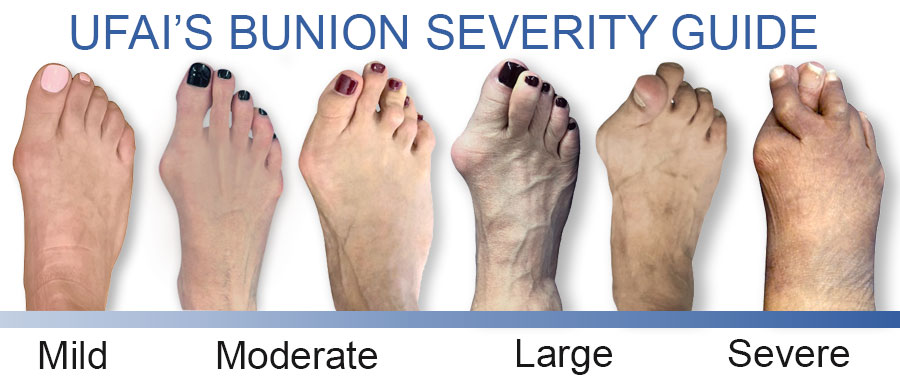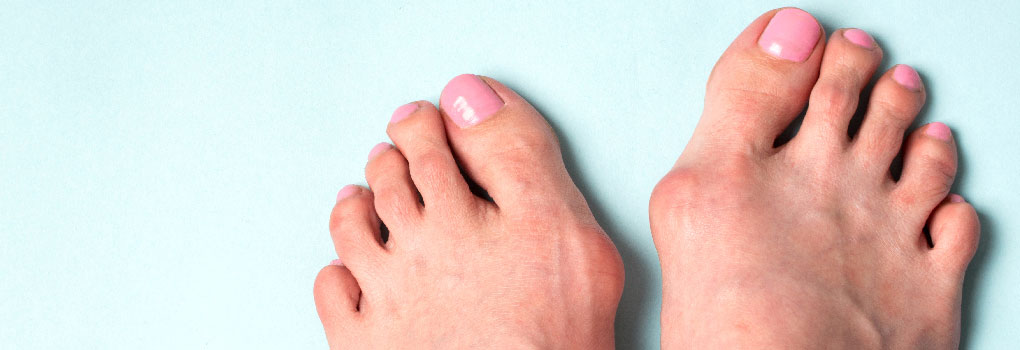What is a Bunion?
A bunion typically appears as a bony bump on the inside edge of the foot, where the innermost bone of the foot meets the big toe.
The visible bump appears when the first metatarsal shifts outward so that the head of the bone protrudes on the inside of the foot near the big toe joint. When the bunion develops on the base of the little toe, it is called a tailor’s bunion
Bunions are one of the most common foot problems, affecting an estimated 25-33% of adults. Bunions occur the most in women and older adults.
A quick tip before we start: don’t ignore a bunion! It’s best to accept it and give them some love and attention to slow their progression and reduce discomfort.
What Causes a Bunion?
There are many causes of bunions that range from whether your family members suffer from bunions to the type of shoes you wear and even your gender. Bunion causes include:
Genetics
Foot types are hereditary. You may have inherited flat feet or loose ligaments, both of which can contribute to bunions.
Structural abnormalities
Missing bones, flattened arches, short first metatarsal bone, asymmetry of the legs, or a foot injury may all result in the development of a bunion.
Pregnancy
Relaxin, the hormone that helps widen the pelvis during pregnancy, can also soften the ligaments in the foot causing the bones in the feet to spread out and arches to fall. This can result in bunions.
Wearing “bad” or “improper” shoes
High heels can cause tight calf muscles resulting in load-bearing to the front of the foot and gradual arch collapse. Additionally, certain shoes, such as pointy or narrow shoes, can force your foot into an unnatural position.
Rheumatoid arthritis
Up to 90% of people with RA develop foot conditions, including bunions.
Gender
We are not exactly sure why this is, but women are more than twice as likely to suffer from bunions than men.
Bunion Stages
There are three stages of a bunion: mild, moderate, and severe. The stage of your bunion can help doctors determine what treatment options are best for you. Because a bunion is a progressive deformity that tends to get worse over time, without treatment, it is more likely to grow and progress to the next stage.

Mild bunions
Technically, you can only “fix a bunion” with surgery, but many patients don’t need it to get symptom relief. In its early stages, the progression of the bunion deformity can often be dramatically slowed. Removing pressure from the bunion area and balancing the tendon and ligament alignment are the primary goals of mild bunion treatment. For example, it is important to wear shoes that have sufficient room in the toe area to accommodate the bunion ─ that means softer leather shoes to mold to the deformity and platform-type heels for better foot and arch support.
Your doctor may also advise the use of pads to protect the bunion from shoe pressure. Customized shoe inserts, called orthotics are made exclusively for your foot and are often used to correct the alignment of the arch and big toe joint. In some cases, physicians also use anti-inflammatory creams around the bunion.
Read about UFAI manufactured custom orthotics here.
Moderate bunions
A bunion is considered moderate when it pushes against the second toe. In fact, over time, the big toe can force itself under the second toe, causing it to buckle and form a “hammer toe.”
If non-invasive treatment is not effective, and the joint is still causing discomfort, the doctor may suggest a bunionectomy to realign the big toe. With this procedure, the bunion head is moved over realigning the angled great toe joint back to a normal position. The tendons and ligaments are also balanced for a more normal pull on the toe.
In moderate bunion cases, you will experience a relatively rapid recovery. The procedure allows for immediate weight on the foot in a boot and returns to tennis shoes in about a month. The choice of procedure best for each patient depends on the deformity size, the stiffness of the 1st metatarsal, and the ease of realignment of the 1st metatarsal during the clinical exam.
Severe bunions
In severe hallux valgus bunion cases, the first long bone (metatarsal) in the foot dramatically shifts away from the second metatarsal, resulting in looseness and a large deformity.
In severe bunion corrections, a surgery known as the Lapidus procedure realigns the first metatarsal into its natural position. Using screws, the surgery holds the bone stable, so it does not shift again and reduces the change of the bunion returning to basically none.
Surgery may also involve removing the enlarged portion of the bunion region, cutting and realigning the bone, and correcting the position of the tendons and ligaments.
By using a special plate with Lapidus procedures, our patients are able to put weight on their foot after only 2-3 weeks, rather than the typical 6-8 weeks.
Is Surgery the Only Way to Fix a Bunion?
Yes and no. Unfortunately, a bunion never goes away on its own and you can only “permanently fix” a bunion with bunion surgery.
Fortunately, there are a number of non-surgical treatments that may help relieve the painful symptoms of a bunion. We are big believers in trying non-surgical options, first whenever possible. Luckily there are a number of options when it comes to conservative bunion care.
Conservative treatments include:
Custom Orthotics
Because bunion formation is often greatly influenced by midfoot instability, adding arch support and hindfoot and midfoot control and correcting the foot position can slow the worsening of bunion deformities. Some modifications and corrections can be built into the orthotic to off-weight pressure to the bunion area.
Shoes
Comfortable shoes with a soft and wide toe box can allow the foot to stretch out without putting pressure on the base of the big toe.
Bunion Pads
These include silicone gel sleeves that cushion directly over the bunion prominence. Moleskin can reduce rubbing in certain shoes. Toe spacers placed between the big and 2nd toe can help better align the big toe.
Prescription Medications
Steroid or cortisone injections can reduce pain in the short term but are quite negative to the soft tissue structures and should be used very sparingly. They can thin the skin and joint capsule.
Over the counter medications
Topical medications like compound creams, BioFreeze, Voltaren gel, Lidocaine patches can all help reduce pain and inflammation. New techniques such as PRP or amniotic membrane injections can improve a painful joint.
Ice packs and over the counter medications such as nonsteroidal anti-inflammatory drugs can also be used to relieve foot pain and reduce swelling.
Physical Therapy, Exercise & Stretching
Stretching exercises and range of motion maneuvers can help reduce bunion discomfort. The 1st metatarsal and big toe begin to assume a position that is out of alignment. Pushing and manipulating the 1st metatarsal over and straightening the big toe, then moving the big toe joint up and down can encourage better motion and position of the big toe. It can also help prevent stiffening of the big toe joint in a misaligned position.
Bunion Splints
There are bunion night splints that place a corrective stretch on the bunion and big toe joint. They can be very helpful to keep the joint stretched out, avoid stiffening in the misaligned position, and can help slow the worsening of the bunion.
Activity Modification
While we hate to recommend a less active lifestyle, if bunions begin to hurt, it may be wise to modify activities. For exercise, choose activities that don’t include repetitive pressure on the ball of your foot (things like lunges and step aerobics may be contributing to bunion pain). There are plenty of exercises with less stress on bunion areas, like a stationary bike, rowing machine, swimming, weight training, etc.
When to Have Bunion Correction Surgery
Many patients ask, “When should I have bunion surgery?” In most cases, we recommend you consider surgery when it is regularly painful and has begun to limit your desired activities. When this happens, it may be time for surgery.
For a young person with an adolescent bunion, we usually hold off until they are thirteen or fourteen when the growth plate in the foot has completely closed.
If conservative bunion treatments don’t work, it’s time to discuss surgical procedures with a highly qualified and experienced foot surgeon.
Years of research and experience have proven that no one bunion removal surgery procedure works for everyone… far from it. Yet the vast majority of bunion surgeons perform just one procedure for all of their patients.
Unfortunately, this leads to a lot of bunion surgery failures. How do we know? Because almost 25% of our bunion surgeries are fixing other doctor’s work, which is terribly sad because the patient needs to go through yet another surgery.
It’s our experience and expertise with the different bunion surgeries that allow us to determine the very best option for each individual patient. This means the quickest, most comfortable, pain-free, and successful surgery available.
UFAI, a Nationally Recognized Bunion Surgery Center of Excellence
We work with manufacturers in the development of surgical products and appliances and always are conducting studies to advance the state-of-the-art technologies used in bunion surgery. Currently, we are studying the relevance of bone marrow infusion and gelling techniques for several types of outpatient bunion surgeries including the Lapidus Procedure.
Our surgeons are often asked to share their experience and expertise. They have published dozens of articles and case studies in many scientific journals, including Podiatry Today and Clinics in Podiatric Medicine and Surgery. They are regularly invited to lecture at The American College of Foot and Ankle Surgeon and Western Podiatric Medical Association conventions, as well as seminars around the world.
Why Choose University Foot and Ankle Institute for your Bunion Care?
If you are experiencing bunion pain, we’re always here to help. We encourage you to schedule a consultation with one of our foot and ankle experts to learn what your best treatment options are.
Our nationally recognized board-certified foot and ankle specialists offer the most advanced podiatric care and the highest success rates in the nation. Our foot surgeons are leaders in the research and treatment of all foot and ankle conditions.
For more information or to schedule a consultation, please call (877) 736-6001 or make an appointment online now.
At University Foot and Ankle Institute, we take our patients’ safety seriously. Our clinics and surgery centers follow Covid-19 patient safety procedures exceed all CDC recommendations. Masks are required in our institutes at all times.
We are conveniently located throughout Southern California and the Los Angeles area as our foot doctors are available at locations in or near Santa Monica (on Wilshire Blvd.), Beverly Hills, West Los Angeles, Manhattan Beach, Northridge, Downtown Los Angeles, Westlake Village, Granada Hills, and Valencia California, to name a few.
- Revolutionizing Extremity Imaging: UFAI’s Open MRI for the Foot and Ankle - October 21, 2023
- Youth Sports and Heel Pain: Should Kids Play with Pain? - April 4, 2023
- All About Foot Arch Pain and Foot Arch Cramps - March 15, 2021

Leave a Reply